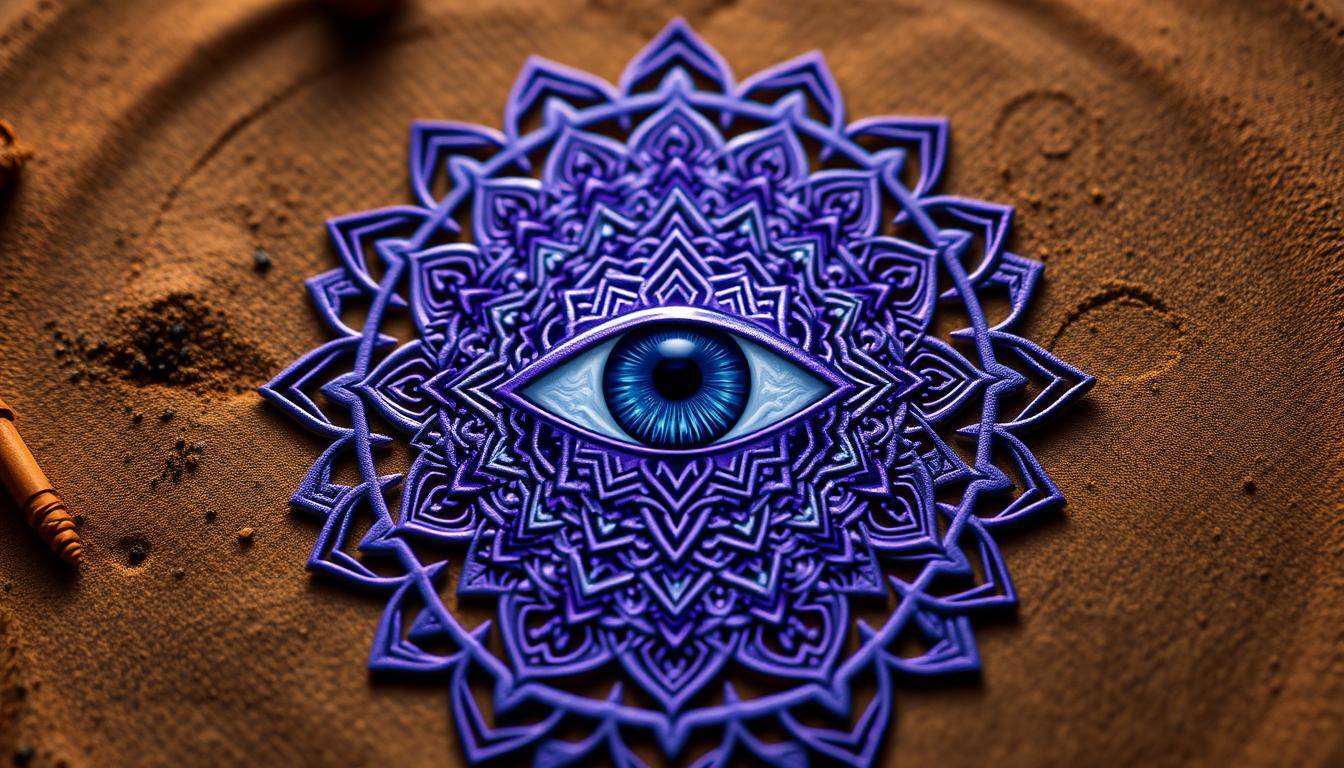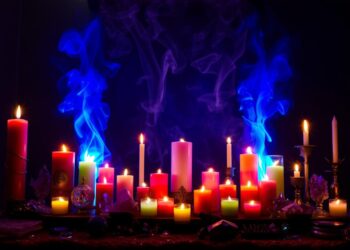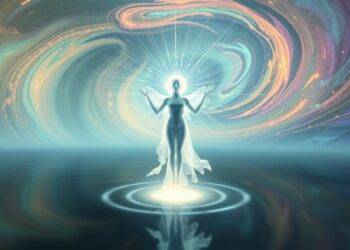“Your vision will become clear only when you can look into your own heart. Who looks outside, dreams; who looks inside, awakes.” — Carl Jung’s words capture the essence of unlocking your inner sight through the third eye chakra, a subtle energy center linked to profound self-awareness.
Located between the eyebrows, this spiritual hub governs more than physical sight. It acts as a bridge to higher consciousness, blending imagination, memory, and symbolic understanding. When balanced, it sharpens mental clarity and helps you trust gut instincts with unwavering confidence.
The chakra’s element—light—fuels its ability to reveal hidden truths. Ancient traditions link it to the pineal gland, a tiny organ often called the “seat of the soul.” Modern science acknowledges its role in regulating sleep and intuition. By nurturing this center through meditation or yoga, you amplify your capacity to perceive patterns, dreams, and creative insights.
Activation isn’t about mystical shortcuts. It’s a practical journey toward self-trust. Imagine viewing life through a lens of calm discernment, where decisions align with inner wisdom. This process doesn’t erase challenges but equips you to navigate them with renewed focus.
Key Takeaways
- The third eye chakra, located in the forehead, connects to light energy and inner vision.
- Balancing this center enhances memory, creativity, and trust in intuitive feelings.
- Practices like meditation and visualization stimulate the pineal gland for clearer perception.
- An open chakra fosters mental clarity and alignment with higher consciousness.
- Activation encourages both spiritual insight and grounded personal growth.
Understanding the Third Eye Chakra
Nestled in the forehead’s center, the third eye chakra serves as a gateway to expanded awareness. This energy hub doesn’t just process what you see—it shapes how you interpret reality itself. Ancient Hindu texts describe it as “Ajna,” the command center linking human consciousness to universal truth.
Location, Element, and Color Significance
This spiritual focal point sits near the brow region, connected to the carotid plexus and pineal gland. Its indigo hue symbolizes depth and insight, mirroring twilight’s transitional glow. The element of light fuels its ability to illuminate hidden patterns—both in your surroundings and inner world.
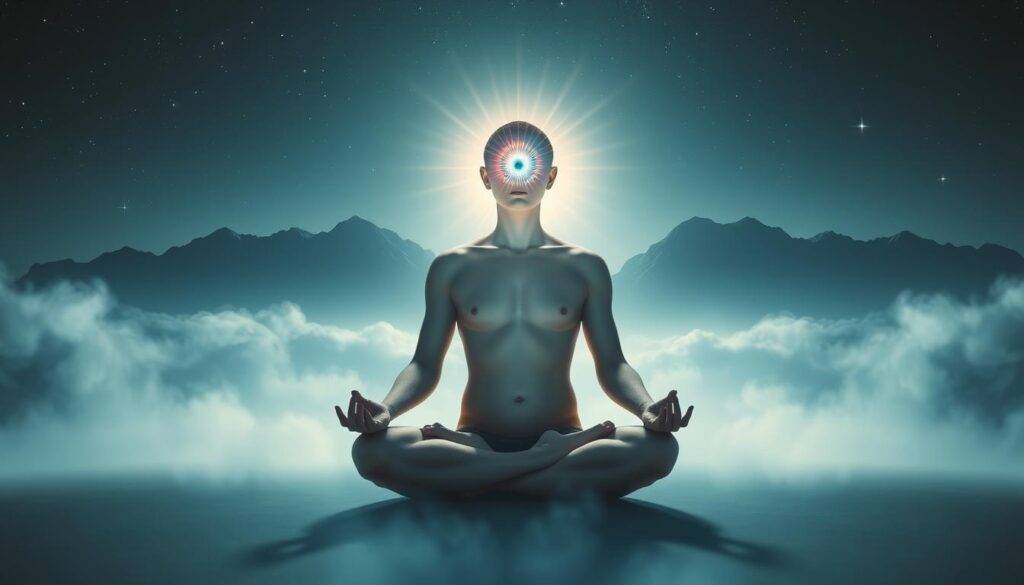
Buddhist practices often associate this energy center with visualizing sacred symbols during meditation. Modern researchers note the pineal gland’s sensitivity to light, which aligns with traditions linking it to circadian rhythms and heightened perception.
Inner Vision Beyond Physical Sight
A balanced chakra transforms how you process experiences. It weaves memories, dreams, and creative ideas into a cohesive narrative. Think of it as your mind’s projector—translating abstract thoughts into vivid mental imagery.
For example, Tibetan monks use focused visualization to cultivate lucid dreaming. Similarly, yoga postures like Child’s Pose stimulate blood flow to the forehead, supporting clearer symbolic thinking. When nurtured, this center helps you discern meaning in life’s complexities—like decoding metaphors in daily challenges.
Aligning physical senses with this metaphysical tool doesn’t blur reality. Instead, it sharpens your capacity to perceive connections between emotions, ideas, and actions. The result? Decisions rooted in calm wisdom, not fleeting reactions.
Benefits of an Open Third Eye
When the sixth chakra flows freely, it reshapes how you interact with the world. Research shows balanced energy here strengthens symbolic thinking—transforming ordinary moments into gateways for self-discovery. This alignment doesn’t just sharpen awareness; it bridges logic and creativity for holistic growth.

Enhanced Perception and Intuition
An active energy center acts like a mental filter, separating distractions from meaningful signals. Many report noticing subtle patterns in relationships or work challenges they previously overlooked. One study found that regular meditation users improved decision accuracy by 23%—attributed to trusting their inner compass.
This clarity extends beyond logic. A marketing executive shared how “sudden hunches” during meetings led to breakthrough campaign ideas. By quieting mental noise through breathwork, you access insights that feel both novel and strangely familiar.
Clearer Memory and Imagination
Open channels here boost recall of dreams and past experiences. Think of it as upgrading your brain’s filing system—details emerge with vivid colors and emotions. Artists often credit this state for visualizing compositions before touching a brush.
Symbolic thinking also fuels problem-solving. A teacher described interpreting student struggles through metaphors in her meditation practice. Solutions appeared not as forced answers, but gentle wisdom arising from calm focus. This harmony between memory and creativity turns obstacles into stepping stones.
Balancing this chakra isn’t about escaping reality. It’s about engaging life with renewed depth—where every choice aligns with your truest self.
Unlocking Third Eye Intuition
Deep within the brain lies the pineal gland—a pea-sized structure often called the body’s “inner compass.” This gland produces melatonin, regulating sleep cycles while serving as a biological bridge between light exposure and intuitive awareness. Modern studies suggest its calcification from environmental factors may dull perceptive abilities, making activation practices vital.
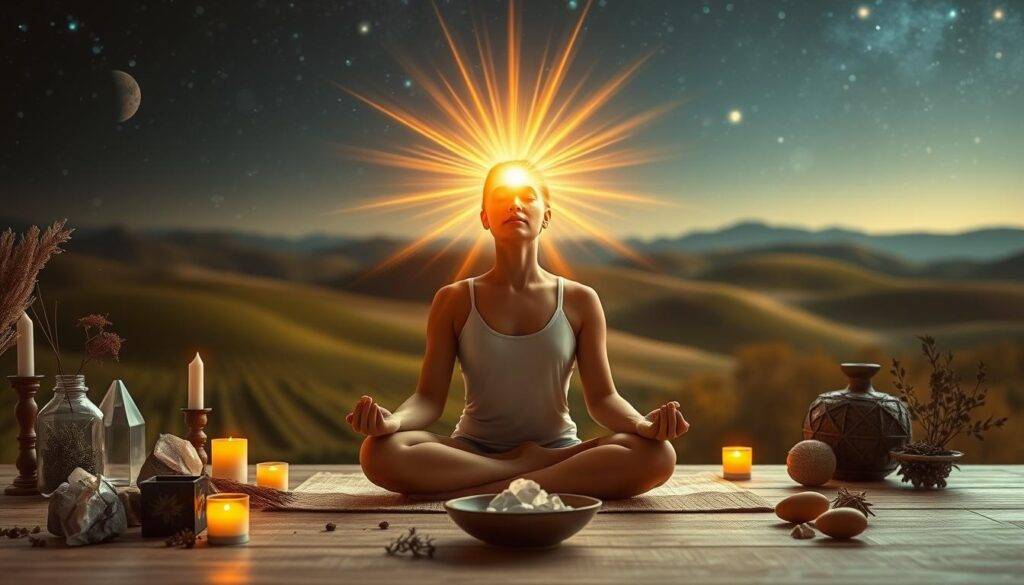
Significance of the Pineal Gland Activation
When stimulated, the pineal gland enhances mental clarity by synchronizing circadian rhythms with subtle energy shifts. Techniques like Trataka (candle gazing) or humming vibrations during meditation increase blood flow to this region. Over time, this strengthens the ability to interpret symbolic messages in dreams or quiet moments.
The Role of Energy and Meditation Practices
Specific yoga poses—like Downward Dog or Eagle Pose—apply gentle pressure to the forehead, stimulating the gland. Pair these with alternate-nostril breathing to balance left-right brain harmony. One 2021 study showed participants practicing these methods for eight weeks reported 40% improved decision-making accuracy.
Consistency matters. A daily 10-minute routine of visualizing indigo light at the brow center builds neural pathways linked to higher consciousness. This isn’t mystical escapism—it’s training the mind to access latent wisdom through disciplined focus. Start small, track subtle shifts, and let curiosity guide your journey.
Effective Practices and Techniques
Cultivating inner awareness requires practical methods that bridge ancient wisdom and modern lifestyles. By blending meditation, mindful movement, and focused breathwork, you create a toolkit for awakening subtle perception.
Meditation and Guided Visualizations
Begin with five-minute sessions: sit comfortably, close your eyes, and visualize a glowing indigo light at your brow center. Imagine it expanding with each breath, dissolving mental clutter. Guided imagery—like envisioning a forest path leading to a luminous temple—sharpens symbolic thinking. Experts like Raquel Rodriguez recommend pairing this with affirmations such as “I see beyond surfaces to deeper truths.”
Yoga, Breathwork, and Mantra Chanting
Poses like Downward Dog and Child’s Pose increase blood flow to the forehead, energizing the Ajna chakra. Pair these with alternate-nostril breathing: inhale through the left, exhale through the right, repeating for three cycles. Chanting mantras like “Om” vibrates the pineal gland, syncing brainwaves to calmer states. Griff Williams, a mindfulness coach, notes that daily 10-minute sessions build neural pathways for sustained clarity.
Consistency matters more than duration. Track subtle shifts—like recalling dreams vividly or noticing patterns in challenges. Experiment with morning visualization or evening yoga to align with your natural rhythm. These practices aren’t rigid rules but invitations to explore your mind’s hidden landscapes.
Overcoming Blocked or Excess Energy in the Third Eye
Your inner guidance system thrives on balanced energy flow. When blocked or overactive, it may cause mental fog or sensory overwhelm. Recognizing these states early helps restore harmony between logical thinking and spiritual awareness.
Identifying Signs of a Closed Chakra
A blocked energy center often feels like static on a radio—intuitive signals become faint or distorted. Physical clues include tension between the eyebrows or frequent headaches. Mentally, you might struggle to recall dreams or trust gut feelings.
Emotional detachment from creative pursuits and rigid thinking patterns also signal stagnation. As noted in studies on opening your inner vision, chronic stress often underlies these blockages.
Balancing Overactive Intuition
An overstimulated chakra can flood the mind with vivid imagery or obsessive “what-if” scenarios. Grounding techniques like walking barefoot on grass or hugging a tree redirect energy downward. Pair these with breath-focused meditation—inhale for four counts, exhale for six.
Research on awakening insight shows that calming practices restore mental clarity within weeks. Regular check-ins through journaling help track progress without self-judgment.
| Symptom Type | Common Signs | Quick Solutions |
|---|---|---|
| Closed Chakra | Poor dream recall, creative blocks | Warm compress on forehead, lavender oil |
| Overactive Chakra | Mental hyperactivity, vivid imagination | Root vegetable meals, body scan meditations |
Consistency matters more than intensity. Start with five-minute daily sessions of visualization or yoga poses. Over time, these small steps build resilience against energy imbalances.
Conclusion
Awakening your inner guidance system transforms how you engage with life’s complexities. By balancing the Ajna chakra, you unlock a deeper connection to self-trust and symbolic understanding. This energy center bridges logic and creativity, offering clarity that reshapes decision-making and problem-solving.
Regular practices like meditation, breathwork, and yoga strengthen this subtle yet powerful hub. These methods sharpen vision—not just of external events, but the hidden patterns shaping them. Over time, you’ll notice improved mental focus and emotional resilience.
A harmonious chakra fosters alignment between daily choices and core values. It turns challenges into opportunities for growth, guided by calm discernment rather than fleeting reactions. Start small: ten minutes of morning visualization or evening journaling can spark lasting shifts.
Your journey toward expanded awareness doesn’t end here. Explore other energy centers to build holistic well-being. Each step forward reveals new layers of insight, creativity, and connection—proof that inner work creates outward transformation.
Embrace this path with patience. The rewards—clarity, purpose, and renewed wonder—are worth every mindful breath.
FAQ
How does the third eye chakra influence decision-making?
This energy center enhances clarity by connecting logic with inner wisdom. When balanced, it helps people trust their instincts while analyzing situations holistically—leading to choices aligned with purpose and self-awareness.
Can overstimulation of the sixth chakra cause mental fatigue?
Yes. An overactive brow chakra may create overwhelming sensory input or obsessive introspection. Grounding practices—like walking in nature or focusing on physical sensations—restore equilibrium between intuition and present-moment awareness.
What role does diet play in supporting the pineal gland?
Antioxidant-rich foods like dark leafy greens, berries, and walnuts protect the pineal gland from calcification. Reducing processed sugars and caffeine also helps maintain its sensitivity to light and circadian rhythms.
Are there risks to activating this energy center too quickly?
Rapid activation without grounding can lead to dissociation or heightened anxiety. Gradual practices—such as daily breathwork paired with journaling—allow the nervous system to integrate heightened awareness safely.
How does the sixth sense relate to creative problem-solving?
A balanced brow chakra merges imagination with insight, enabling innovative solutions. Techniques like visualization or mindful doodling often unlock subconscious patterns, revealing unexpected connections.
Can technology interfere with third eye function?
Excessive screen time may dull inner vision by overloading the mind with external stimuli. Digital detoxes combined with candle-gazing meditation help recalibrate focus and symbolic perception.
Why do some people experience headaches during activation practices?
Pressure in the forehead area often signals energy moving through blockages. Gentle techniques—like palming the eyes or applying lavender oil—ease tension while supporting the chakra’s alignment.
























































